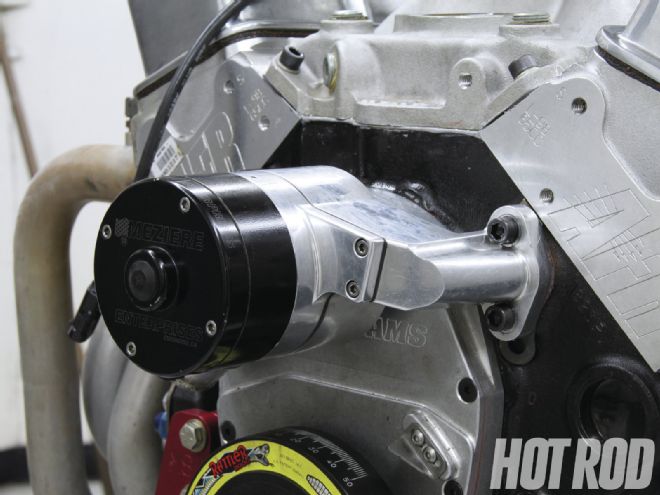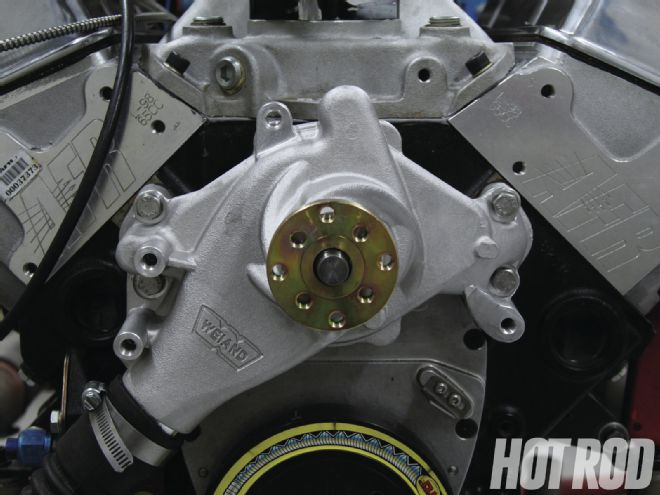
The Premise
In our world, engine accessories are a power-robbing necessity. That's why aftermarket companies have come up with parts to minimize the losses. But is the power lost by spinning these accessories worth the money spent trying to offset the losses? We wondered how much power it took to spin a high-flow water pump versus a stocker, so we dyno-tested both setups on an engine, then compared the results with the same engine using an electric water pump. We went a step further and bolted up a set of underdrive pulleys to see if we could get back some of the power eaten up by the mechanical water pumps. Finally, we put a high-output alternator into the mix to see how much power it ate up when under a load.
The Stuff
Our baseline testing was done using a Meziere Series 100 electric water pump (PN WP101U, $309.95 at SummitRacing.com). This pump flows 35 gallons per minute, draws 8 amps of current, and weighs just 51?2 pounds. We also picked two mechanical water pumps from Summit. The first was an aluminum Weiand Action Plus (PN WND9240, $97.95), which weighs 6.85 pounds. Its six-blade, stamped-steel impeller not only flows better than a stocker but is said to reduce cavitation at high speeds. The Action Plus is a street/strip type of pump with a heavy-duty shaft and premium bearing, and it's leak-tested at the factory. The second pump was an iron GMB North America replacement pump (PN 130-1250, $35.95) that features a high-flow impeller, sealed bearings, and a forged housing designed to increase flow. It weighed 13.15 pounds.

Weiand’s Action Plus mechanical pump weighs about 1.3 pounds more than the Meziere pump and only required 3.7 hp to spin, but it also requires the expense and weight of pulleys and a belt.
Trans-Dapt billet aluminum pulleys (PN 9483, $63.95 and PN 9486, $65.95) provided a near-stock pulley ratio (1.01:1), while a set of March underdrive pulleys (PN 6090, $193.88) slowed down the water-pump pulley with a 0.87:1 drive ratio to free up some horsepower.
Finally, we added a Powermaster high-output alternator (PN 478021, $188.95) to the accessory drive to see how much power it consumed. This one-wire alternator puts out 80 amps at idle speed and 140 amps max, more than enough to power electric fuel pumps, a huge audio system, or whatever else you want to attach to the battery.
The Test
The same AFR-headed 372ci small-block Chevy we ran during the tach test (see pg. 78) was used here. We made three pulls with each combination of parts, made sure the water and oil temps were identical at the start of each pull, then averaged the results using SuperFlow's Windyn software.
The Results
Using the Meziere electric pump and no other accessories, the small-block put out 531.2 hp at 6,600 rpm and 475.9 lb-ft of torque at 5,300 rpm (as an average of the three pulls). We bolted on the Weiand Action Plus water pump and Trans-Dapt 1.0:1 billet aluminum pulleys and found 527.5 hp and 474.5 lb-ft of torque at the same rpm points, resulting in a loss of 3.7 hp and 1.4 lb-ft. Next, we simulated the restriction that a pressurized, closed cooling system would place on the water pump by installing a restrictor plate with a 5/8-inch hole in the water neck. We found no difference in power.
We swapped the Trans-Dapt parts for the March Performance underdrive pulleys and regained almost all of the lost performance from the mechanical pump. The dyno kicked back 530.8 hp and 474.1 lb-ft on average, almost making the mechanical water pump and underdrive pulleys the Meziere's equal in power.
When we swapped to the GMB water pump, using the March underdrive pulleys, we recorded an average of 523.1 hp and 470.9 lb-ft of torque, 8.1 hp less than the Meziere electric pump and 4.4 hp less than the Weiand mechanical pump.
We used the Weiand water pump when we tested the Powermaster alternator, wiring it directly to the battery powering the dyno. The battery had a full charge but still needed to power the MSD Digital 7 spark box and Aeromotive A1000 electric fuel pump. The alternator ate up 8.1 hp and almost 4 lb-ft of torque.
Conclusions
The lightest and most powerful combination of parts was the simplest--the Meziere electric water pump. It was also the most expensive at $309.95. The Weiand/March pulley combo yielded almost the same amount of power output as the electric pump--equipped engine did for $291.83. The Weiand mechanical pump also required less power to turn than the GMB pump, but the GMB pump was $62 cheaper. The question remains as to how well any these cooling combos will cool on the street. An engine dyno won't tell you that no matter how nicely you ask it.
The alternator did sap a substantial amount of power, but if you have a lot of electronics in your hot rod it's certainly an acceptable loss. If you're really concerned about the power loss, you can rig a setup to bypass the alternator at WOT.
Bottom Line
For some, the simplicity of the electric water pump (no belts or pulleys to fail) is often overshadowed by their worry about it failing, though many of the cars at Drag Week and elsewhere have proved they are pretty reliable. For max power and minimum weight, it's the way to go. Electric water pumps also allow you to cool the engine without having to run it. If the sight of belts spinning pulleys makes you happy, and you don't mind losing a few ponies to parasitic losses, then go with mechanical cooling. The underdrive pulleys will make up most of the lost power, anyway. Finally, we learned that Powermaster makes a really powerful alternator that requires almost double-digit power numbers to spin when it's under load.

 Weiand’s Action Plus mechanical pump weighs about 1.3 pounds more than the Meziere pump and only required 3.7 hp to spin, but it also requires the expense and weight of pulleys and a belt.
Weiand’s Action Plus mechanical pump weighs about 1.3 pounds more than the Meziere pump and only required 3.7 hp to spin, but it also requires the expense and weight of pulleys and a belt.